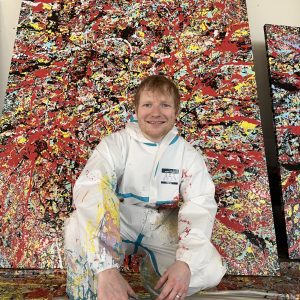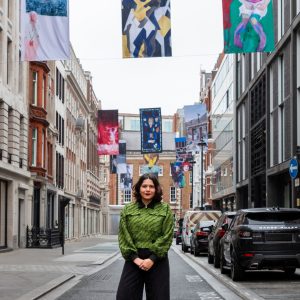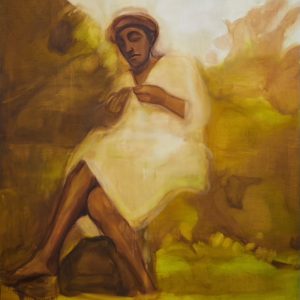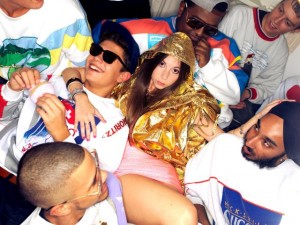
Artist Helen Carmel Benigson (born 1985) is also rapper Princess Belsize Dollar. An emerging artist to look out for, Benigson’s performances and colour saturated videos, objects and installations register the phenomena of the present. This is the age of surfaces that, from plasma screen to mobile phone, blur the boundaries between our bodies of flesh and blood and the avatars and identities we imagine into being on-line. Technologies of screen and surface are departure points for works that appear as seamless dreams and fantasies, while they are self-conscious performances of identities, desires and states of being. Yvette Greslé chats to Helen about her work and her forthcoming documentary art film ‘Talmy’.
‘Talmy’ premiers at the UK Jewish Film Festival on Sunday 18 November, 4.45 pm at the Tricycle Cinema, Kilburn: ukjewishfilm.org/films/talmy
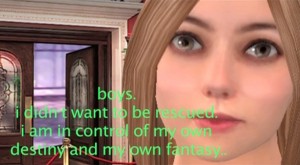
YG: What are the questions that drive you as an artist? The way you move across media and play with persona is very interesting – you are both an artist and Princess Belsize Dollar, a rapper.
HB: Crucial is the idea of the screen – performing to the screen, and performing for and within the screen. I’m interested in what it means to perform as an online identity. How performance becomes real whether it is online, in real territory, imagined space or different geographical locations. I’m interested in the relationship between body and screen. How the everyday gesture has the potential to be a performative act and the implications of performance negotiated by the screen.
YG: Tell me a bit more about the screen, as a surface you work with.
HB: I’m really interested in the screen as a skin and plasma screens. How they can be bodily and visceral. My aim is to create a screen that operates solely within the body.
YG: It sounds as though you’re very interested in how different kinds of realities and spaces converge. How do you go about making these ideas happen in practice?
HB: The physicality of filming is really important – the mechanism of recording, editing, cutting. I film a lot underwater using an underwater sports camera, a GoPro. It’s high definition, and it has really high sound quality. For me the underwater camera is the most visceral of cameras. I’m also really interested in internal medical cameras and how they can capture the inside of the body. I’m making a video using images of my dad’s lungs. But for me the underwater camera is the closest to what I’m always trying to get to within the screen.
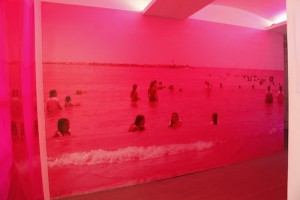
YG: What interests you so much about water? It comes up a lot in your work.
HB: My new film ‘Talmy’ (screening at the Jewish film festival) has scenes throughout the film of a woman swimming. It’s like a return to the womb or a space that’s meditative, an inside space.
YG: What’s ‘Talmy’ about?
HB: ‘Talmy’ tells the story of a Jewish woman, Thelma Syzmson Koorland, born in 1936 in Poland. The film traces her early life in Warsaw, Paris and later Cape Town. At the age of seven, Thelma’s parents were killed in the Warsaw Ghetto and this marked the beginning of her lone journey through bitter winters, hiding in haystacks, false identities and living with 5 different families. As an adult, Thelma has collected incredible Staffordshire figures and antique ornaments and has re-invented her own history through these objects. The film replays and renegotiates Thelma’s narrative, through recent interviews with Thelma and her daughter, the artist Vivienne Koorland and the objects and paintings that she has in her house. The narrative is intercut with scenes of today’s Thelma swimming in a bright blue pool
YG: This is an actual person that you know. What brought you to this story?
HB: Yes. I always wanted to make a piece about her. I was compelled to make this story because I have always felt drawn to Thelma – a woman who represents the glamour of the past, a surrogate grandmother, with her gold and diamonds and furs and her amazing collections of dollhouses, Staffordshire figures and antique objects, her mixed up accent, her other-worldly smell, her smudged red lipstick. As a child I would stare longingly at the objects, dreaming of stories, imagining what the objects could possibly mean, where they could be from and trying to get closer to this woman – so warm and loving on the one hand and yet a woman who has clearly lived her whole life with the trauma of war. I think the film conjures up these ideas about Thelma, but goes further and draws on the absence of memory; the reinvention of personal history through archiving and collecting; and familial care structures. The film is 23 minutes long.
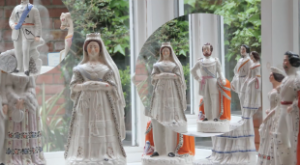
YG: You seem to have relationships with many places: London, LA, Tel Aviv, Cape Town. Jewish heritage is also an important thread in your work.
HB: I guess it’s this idea of displacement. How identity transforms or doesn’t transform according to place and space, and disjunctures between these territories. What happens when you move between these or don’t move between these. I’ve always felt a sense of displacement because my family is South African, from Germany and Lithuania and Jewish. I’m interested in how identity transforms between different territories and how my own shifts in relationship to these different places. I constantly dissect how online identity and our own bodies transform when clicking through different windows on an Internet screen. Last week, I made Ashkenasi date balls for the Jewish New Year but accessed the recipe on my iPhone.
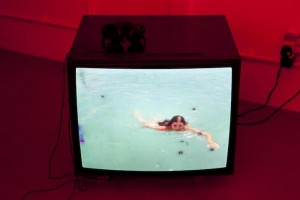
YG: So everything comes back to the screen in a sense. It’s interesting to think about water again, its fluidity and how it’s also a metaphor for migration. Your work really tries to get under the surfaces of screens and digital technology (and their aesthetics). Saturated colour and deliberate pixilation are very present in your work.
HB: I think of pixels as parts of the body, as cells that build up to create this abstraction or picture. I enjoy images that are pixelated and it’s interesting when you see colours that are blown up or images that are blown up – so much that it just becomes a series of pixels. I really like the process of printing things out. I think the print is really important to my work. I like performing the print. A print coming out of the printer becomes a sort of performance. I like the idea of the print ejecting paper which has the ink on it. It’s the build up of an image through ink on paper. Colour in my work is always very exaggerated and hyped up. It’s saturated to the extreme. Thinking about the edit is very important. The mechanics of editing, adding things together and the point at where the performance and the edit meet is important.

YG: You seem to see yourself a bit like a digital phenomenon. You’re a human being in a body of flesh and blood but at the same time being part of a generation where your consciousness, and imagination and body inhabits a digital realm, a virtual realm which is always present. There’s always that absorption.
Tell me about Princess Belsize Dollar?
HB: That name was born in LA. I’m obsessed with LA. I love LA and I just came up with the name there. My brother works with me on the rap and we write many of the songs together. I was working with Helen Bellringer who does some of the music. She’s a musician who’s made some of the tracks. About seven years ago, Farma G from Taskforce taught me to rap because I really wanted to learn to rap. I asked all my brother’s friends if they could teach me to rap and they all said no. So then I approached Taskforce and they ended up teaching me to rap.
YG: Do you think rapping is dominated by boys
HB: No not really. I like the sound of rap, and text and I think rap is a really clever way of speaking about things. I use the lyrics in my monoprints.
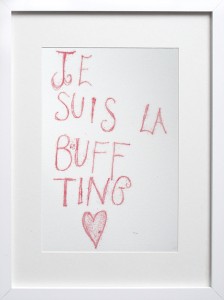
YG: What do you think about branding? Is that something you play with, in your work?
HB: I just think growing up in London 2012, we’re all experts in branding and we’re all experts in social networking. It’s just a natural mechanism. Princess Belsize Dollar is endorsed by Adidas.

For more about Helen Benigson www.helenbenigson.com
Helen is a LUX associate artist 2011/2012: http://www.lux.org.uk/education/helen-benigson
Next week, Thursday 11 October, Benigson is curating ‘The On Switch’ – a series of films with Elizabeth Price, Breda Beban, Emily Wardill, Martha Rosler, Helen Benigson, Carolee Schneemann, Claire Hooper, Edward Thomasson, Nicole Morris, Patricia Lennox-Boyd, Sophie Lee and Andy Lacey – at the Margaret Street gallery. The screening starts at 6.30, and is part of two nights of film: www.margaretstreetgallery.com

